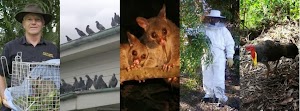All native animals and plants in Queensland are protected under the Nature Conservation Act 1992 (the Act). So anyone catching, trapping, handling or controlling a native animal MUST hold the correct permit for the activity.
There are many types of permits and details can be found on the website of the Department of Environment and Heritage Protection:
https://environment.des.qld.gov.au/licences-permits/index.html
Peter the Possum & Bird Man has held a Damage Mitigation Permit for many years. It allows us to trap brush turkeys and possums. The permits specify how each type of animal must be handled and released.
Every quarter, we must send a report to the relevant department summarizing the activities we have completed under the permit.
For possums, our permit, as with every Damage Mitigation Permit issued for possums, requires that when using a possum trap the animal MUST be released at a suitable site within 25 meters of the location where it is captured; this is because possums are very territorial and it has been shown if they are relocated, a very high percentage will die. They die because they do not know where to hide from predators or know the safe places to find food, and they also get attacked by the resident possums, whose territory they have landed in!
For Brush Turkeys, we are allowed to relocate them to suitable rainforest within their normal distribution range. We cannot hold a Brush turkey for longer than 3 hours. Relocation is permitted because they are an animal that normally roams about and does not have a specific territory, except for males in the breeding season. So the only restriction on moving brush turkeys is that when a male is managing a nest with eggs inside, we must wait until the eggs hatch.
General Guidelines
As part of the regulations protecting our native animals and plants, anyone wanting to take, keep or use native plants and animals needs a permit. The laws accept that sometimes wildlife is in conflict with humans and it may be necessary to interfere with them to protect crops, property and peoples safety. These are the main reasons for a Damage Mitigation Permit.
Peter the Possum & Bird Man, as a holder of a damage Mitigation Permit is NOT allowed to keep the possums snakes or turkeys captured for any longer than the minimum time required to solve the problem they have caused. If any of the animals caught are injured they must be passed to a vet or animal carer who has the appropriate licence for that purpose.
If you wish to care for injured wildlife or keep native animals or hold them to show other people, then there are specific licences for that.
To be issued with a damage mitigation permit , the general guidelines require that you have to show:
- there is a real need to take the wildlife
- you have taken reasonable measures to control the damage in other ways, without success.
- that significant economic damage is being caused or is likely to be caused
- the proposed method will be effective
- the technique used for taking the wildlife is humane;
- the impact of the activity will not detrimentally affect ecological sustainability.
Note: Many activities involving non-lethal crop protection or actions, such as the capture and release of snakes and possums, require a damage mitigation permit.
For some animals like live trapping and removal of magpies and snakes, you need to have references from other skilled people that you have the ability to safely catch and handle these animals. To trap and remove brush-tailed possums a written statement is required demonstrating your experience.
The legislations aim is to protect biodiversity by regulating the taking, keeping, use and movement of wildlife for any purpose, including commercial and recreational.
Under the Nature Conservation Act 1992, all native birds, reptiles, mammals and amphibians plus some butterflies, spiders and scorpions, freshwater fish and the grey nurse shark are protected. Other aquatic species are protected under laws managed by the Department of Agriculture, Fisheries and Forestry and the Great Barrier Reef Marine Park Authority. All indigenous plants are also protected. The objective is to prevent unsustainable exploitation.







